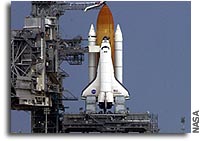NASA Strategic Management Council Meeting: Who Decides About Taking On Risk?

Excerpt from NASA Strategic Management Council Meeting Minutes 2 November 2006
Griffin described an incident that took place preparing for the launch of STS-115, when there was a last minute decision on whether or not to fly with three out of four ecosensors. Where nearly everyone decided to vary slightly from what had been agreed upon and to fly, flight crew ops raised an objection. Subsequent to the flight, Ellen Ochoa, Director of Flight Crew Operations, asked about the role of her organization in the Agency’s new governance model.
Griffin presented his initial thoughts that those who undertake dangerous jobs at NASA, not limited to astronauts, do so as volunteers and that a volunteer can always decline. Management judgment is critical: the Agency should not allow people to take on more risk than absolutely necessary. When the individual cannot speak for him/herself, such as the case where an astronaut is strapped in the orbiter ready to launch, a representative should speak for him/her.
Griffin sees no institutional element as having veto power; he is not willing to cede the authority of the administrator to any single organization or manager. He does not want to put the Agency is the position where it can be brought to a halt by a single manager whose risk tolerance is out of bounds with the rest of the leadership. Griffin is not limiting the question to astronauts. He posed the question: how does NASA decide whether an activity will or will not be authorized?
Bryan O’Connor, Chief of Safety and Mission Assurance, stated that there is a draft policy document that covers this issue, where the requirement is for the program manager to have an agreement from the risk-taker; the program manager must obtain “informed consent” before going forward on residual risk issues.
Scott Horowitz, ESMD Associate Administrator, also noted that risk-taking has temporal issues, stating that a crew on the launch pad is almost always “go” for launch. Griffin invited his members to comment.
SMC Action: Members will provide to PA&E a list of the strategic capabilities NASA should maintain or grow by the next SMC.








